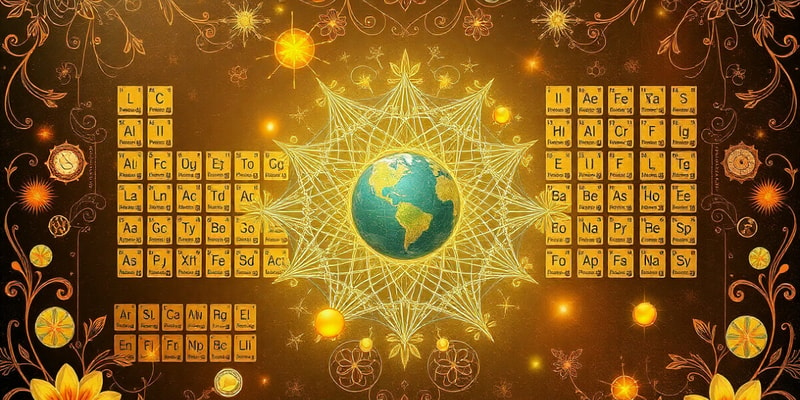Podcast
Questions and Answers
Gold is represented by the symbol 'Ag' in the periodic table.
Gold is represented by the symbol 'Ag' in the periodic table.
False
The term 'congener' refers to elements that are in the same horizontal row of the periodic table.
The term 'congener' refers to elements that are in the same horizontal row of the periodic table.
False
The elements in Group II are known as alkaline earth metals.
The elements in Group II are known as alkaline earth metals.
True
Element symbols are often derived from Greek and French names.
Element symbols are often derived from Greek and French names.
Signup and view all the answers
Transition metals are found between Groups I and II in the periodic table.
Transition metals are found between Groups I and II in the periodic table.
Signup and view all the answers
Sodium belongs to the alkali metals category.
Sodium belongs to the alkali metals category.
Signup and view all the answers
Mercury is known for its metallic lustre and is classified as a non-metal.
Mercury is known for its metallic lustre and is classified as a non-metal.
Signup and view all the answers
Elements in the f-block are known as lanthanides and actinides.
Elements in the f-block are known as lanthanides and actinides.
Signup and view all the answers
The symbols for elements are always one-letter abbreviations.
The symbols for elements are always one-letter abbreviations.
Signup and view all the answers
Halogens are found in Group VII of the periodic table.
Halogens are found in Group VII of the periodic table.
Signup and view all the answers
Metalloids exhibit properties that are solely characteristic of non-metals.
Metalloids exhibit properties that are solely characteristic of non-metals.
Signup and view all the answers
Electrons are located within the nucleus of an atom.
Electrons are located within the nucleus of an atom.
Signup and view all the answers
The atomic number represents the total number of protons in the nucleus of an atom.
The atomic number represents the total number of protons in the nucleus of an atom.
Signup and view all the answers
The mass of an electron is equivalent to 1836 times the mass of a proton.
The mass of an electron is equivalent to 1836 times the mass of a proton.
Signup and view all the answers
Isotopes are atoms that have different numbers of protons but the same atomic mass.
Isotopes are atoms that have different numbers of protons but the same atomic mass.
Signup and view all the answers
Natural abundance refers to the percentage of an isotope present in an artificial sample.
Natural abundance refers to the percentage of an isotope present in an artificial sample.
Signup and view all the answers
The mass of Carbon-12 is approximately 1.99 x 10–23 g.
The mass of Carbon-12 is approximately 1.99 x 10–23 g.
Signup and view all the answers
Ernest Rutherford proposed the concept of a positively charged nucleus.
Ernest Rutherford proposed the concept of a positively charged nucleus.
Signup and view all the answers
The mass number of an atom is calculated by adding the number of protons and electrons.
The mass number of an atom is calculated by adding the number of protons and electrons.
Signup and view all the answers
The natural abundance of Uranium-235 is approximately 91%.
The natural abundance of Uranium-235 is approximately 91%.
Signup and view all the answers
Deuterium has a mass number of 1.
Deuterium has a mass number of 1.
Signup and view all the answers
The average atomic mass of an element considers only its most abundant isotope.
The average atomic mass of an element considers only its most abundant isotope.
Signup and view all the answers
Tritium is a stable isotope of hydrogen.
Tritium is a stable isotope of hydrogen.
Signup and view all the answers
Carbon-12 has a mass of 12.000 u.
Carbon-12 has a mass of 12.000 u.
Signup and view all the answers
Chlorine-35 is denoted with a mass number of 35 written as a subscript.
Chlorine-35 is denoted with a mass number of 35 written as a subscript.
Signup and view all the answers
The mass number of an isotope is the sum of its protons and neutrons.
The mass number of an isotope is the sum of its protons and neutrons.
Signup and view all the answers
The percent abundance of Carbon-13 is higher than that of Carbon-12.
The percent abundance of Carbon-13 is higher than that of Carbon-12.
Signup and view all the answers
The average atomic mass is calculated by rounding each isotope's mass to the nearest integer.
The average atomic mass is calculated by rounding each isotope's mass to the nearest integer.
Signup and view all the answers
The precise mass of an isotope for mass number 13 is indicated as 13.003 u.
The precise mass of an isotope for mass number 13 is indicated as 13.003 u.
Signup and view all the answers
Hydrogen is the only element with isotopes that have the same number of protons.
Hydrogen is the only element with isotopes that have the same number of protons.
Signup and view all the answers
The mass of one atom of carbon-12 is exactly 12 u.
The mass of one atom of carbon-12 is exactly 12 u.
Signup and view all the answers
The average atomic mass of carbon is 12.011 amu due to the presence of carbon-14.
The average atomic mass of carbon is 12.011 amu due to the presence of carbon-14.
Signup and view all the answers
Avogadro's Number, NA, is equal to 6.022 x 10^23 mol–1.
Avogadro's Number, NA, is equal to 6.022 x 10^23 mol–1.
Signup and view all the answers
One mole of atoms is equivalent to 6.022 x 10^22 atoms.
One mole of atoms is equivalent to 6.022 x 10^22 atoms.
Signup and view all the answers
Deuterium has one neutron and is an isotope of hydrogen.
Deuterium has one neutron and is an isotope of hydrogen.
Signup and view all the answers
The molar mass of gold (Au) is approximately 197 g/mol.
The molar mass of gold (Au) is approximately 197 g/mol.
Signup and view all the answers
The mass of one mole of carbon-12 is 12 grams.
The mass of one mole of carbon-12 is 12 grams.
Signup and view all the answers
The number of moles in a substance can be calculated by dividing the mass of the sample by its molar mass.
The number of moles in a substance can be calculated by dividing the mass of the sample by its molar mass.
Signup and view all the answers
Carbon-13 has 8 neutrons.
Carbon-13 has 8 neutrons.
Signup and view all the answers
Isotopes of an element have the same number of neutrons but different numbers of protons.
Isotopes of an element have the same number of neutrons but different numbers of protons.
Signup and view all the answers
Study Notes
Atomic Structure
- The smallest particle of an element that retains the chemical properties of that element is called an atom.
- An element is a substance composed of atoms with identical chemical properties.
Periodic Table
- Groups are vertical columns.
- Periods are horizontal rows.
- Congeners are elements within the same group.
- Alkali metals are in Group I (Na, Li, K, Rb, Cs).
- Alkaline earth metals are in Group II (Be, Ca, Mg, Sr, Ba).
- Halogens are in Group VII (F, Cl, Br, I).
- Noble gases are in Group VIII (Kr, He, Ne, Xe, Rn).
- Transition metals are located between Groups II and III.
- The s-block includes Groups I and II.
- The p-block includes Groups III through VIII.
- The d-block includes the transition metals.
- The f-block includes the lanthanides and actinides.
Metal, Non-Metal, Metalloid
- A metal conducts electricity, has a metallic luster and is malleable and ductile.
- A non-metal does not conduct electricity and is neither malleable nor ductile.
- A metalloid has the physical appearance and properties of a metal but behaves chemically like a non-metal (Si, Ge, As, Te).
Atomic Particles
- Electrons: discovered by J.J. Thomson, have one negative charge, denoted by e-, charge = 1.6 x 10^-19 C, mass = 9.1 x 10^-28 g
- Protons: discovered by James Chadwick, have one positive charge, denoted by p, are 1836 times heavier than an electron, and are located in the nucleus.
- Neutrons: have no charge, are located in the nucleus and have a mass almost identical to protons.
Nucleus of an Atom
- The nucleus was discovered by Ernest Rutherford.
- The nucleus is positively charged and contains both protons and neutrons.
Atomic Number (Z)
- The atomic number is denoted by Z.
- It represents the number of protons in the nucleus.
- The atomic number appears above the chemical symbol.
- Because an atom is electrically neutral, the number of protons in the nucleus is equal to the number of electrons outside it.
- The atomic number can be added as a subscript to the left of the chemical symbol.
- The mass number (A) is calculated by adding Z (protons) and N (neutrons).
- For example, Au has Z = 79, meaning it has 79 protons and 79 electrons.
Mass of an Atom
- The mass of an atom is measured using mass spectrometry (MS).
- For example: The mass of a hydrogen atom is 1.67 x 10^-24 g, and the mass of a carbon-12 atom is 1.99 x 10^-23 g.
Isotopes
- Isotopes are atoms of the same element that have the same atomic number (Z) but different atomic masses (A).
- Isotopes have the same number of protons, but different numbers of neutrons.
- They are called isotopes because they occupy the same place (iso- equal place) in the periodic table despite different masses.
- For example: Hydrogen (H), Deuterium (D), and Tritium (T) are isotopes of hydrogen.
Isotopic Abundance and Natural Abundance
- Isotopic abundance is the percentage of a given isotope present in a sample of the element.
- Natural abundance is the abundance of an isotope in a sample of naturally occurring material.
- For example: Natural abundance of Neon-20 is 91%, and the natural abundance of Uranium-235 is 0.7%.
Mass Number (A)
- The mass number (A) is the total number of protons and neutrons in the nucleus of an atom.
- If you know the mass number (A) and the atomic number (Z) for a given isotope, you can determine the number of neutrons by subtracting the atomic number from the mass number.
- Isotopes are named by writing the mass number after the element name, such as chlorine-35 and chlorine-37.
- The mass number (A) appears as a superscript to the left of the chemical symbol.
Average Atomic Mass
- The average atomic mass (atomic weight) is the relative atomic mass of an element taking into account the natural abundances of each isotope.
- To calculate the average atomic mass, you need the exact atomic mass of each stable isotope and its percentage abundance.
- Multiply the exact atomic mass of each isotope by its percentage abundance (as a decimal).
- Sum the results and round to the appropriate number of significant figures.
- For example, for Carbon:
- Carbon-12: Mass = 12.000000 u, Abundance = 98.90%
- Carbon-13: Mass = 13.003355 u, Abundance = 1.10%
- Average atomic mass of Carbon = (12.000000)(0.9890) + (13.003355)(0.0110) = 12.011 amu
Relative Atomic Mass
- One atomic mass unit (1 u) is defined as 1/12th the mass of a carbon-12 atom.
- Therefore, the mass of a Carbon-12 atom is exactly 12 u.
- The mass of a single carbon-12 atom is 1.9926 x 10^-23 g.
- 1 atomic mass unit (u) = 1.6605 x 10^-24 g
The Mole
- One mole of atoms of any element is equal to 6.022 x 10^23 atoms, known as Avogadro's number (NA).
- The number of atoms in 12 g of carbon-12 is equal to 1 mole.
- The SI unit for the mole is mol (not M, which is used for molar concentration).
Molar Mass
- Molar mass is the mass of one mole of atoms of an element.
- It is calculated by multiplying the average mass per atom by the number of atoms per mole.
- The value for molar mass (g/mol) is numerically identical to the average atomic mass in atomic mass units (amu).
- Examples: 1 mol Au = 196.97 g, 1 mol Cu = 63.54 g, 1 mol Hg = 200.59 g.
- To calculate the number of moles in a sample, divide the mass of the sample by the molar mass of the substance.
- For example: 15 g of Cl = (15 g) / (35.45 g/mol) = 0.423 mol Cl
Studying That Suits You
Use AI to generate personalized quizzes and flashcards to suit your learning preferences.
Related Documents
Description
This quiz explores key concepts in atomic structure and the organization of the periodic table. It covers the properties of elements, including metals, non-metals, and metalloids, along with their classification on the periodic table. Test your understanding of these fundamental concepts in chemistry.




